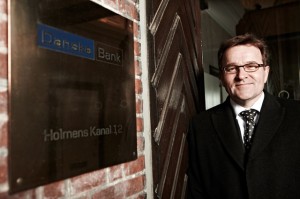Danske beats expectations but pares down full year guidance
Aug 1st, 2013
Danske Bank’s second quarter results announced today (Thursday) beat expectations but the bank lowered its guidance for the full year. The Danish lender reported after a slew of results from other major Nordic banks in July.
 Danske posted a 21% increase in profit before tax, which reached Dkr2.68bn (Eu360m) in the second quarter. Return-on-equity after tax increased to 6.2%, while total income fell 3%, a decline due to lower net income from the group’s insurance business.
Danske posted a 21% increase in profit before tax, which reached Dkr2.68bn (Eu360m) in the second quarter. Return-on-equity after tax increased to 6.2%, while total income fell 3%, a decline due to lower net income from the group’s insurance business.
Impairments in Danske’s core markets declined by 37% to Dkr900m, which corresponds to a loan loss ratio of 19bp, the lowest level since the second quarter of 2008.
Core Tier 1 and total capital ratios rose from the first quarter, and stood at 15.6% and 21.8%, respectively, versus targets of at least 13% and 17% by the end of the year.
Overall, however, Danske revised its guidance for the full year, for net profit of Dkr6.5bn-Dkr9bn rather than Dkr7.5bn-10bn.
“The difficult macroeconomic environment with low interest rate levels combined with the volatility in the financial markets in June have led us to revise our guidance for full-year 2013,” Eivind Kolding, Danske’s chief executive officer (pictured), said today.
Danske’s results come some two weeks after major Swedish banking groups reported second quarter results. After SEB, Swedbank, Nordea and Svenska Handelsbanken had published figures, an equity analyst in Stockholm said that certain trends in evidence in the Nordic region are likely to be characteristic of the banking sector in the coming years: slowing volume growth and revenue growth deriving mainly from margin expansion and higher commissions.
“The big difference between the Nordic region (at least Sweden) and the euro-zone remains asset quality,” he said.
Nordea and Svenska Handelsbanken reported second quarter results on 17 July and the analyst said that they “confirm that these banks are in a league of their own, with large surplus capital compared to European banks’ standards and yet a high return-on-equity”.
The banks’ CET1 ratio was above 13%, he said, even reaching 18% at Handelsbanken, while their return-on-equity (ROE) was also high — 11.5% for Nordea and 15% for Handelsbanken.
In comments on Nordea’s results, chief executive officer Christian Clausen highlighted outcomes such as an improvement in the bank’s core tier one capital ratio to 14% and a pro forma Basel III Core Tier 1 capital ratio of at least 14%. Loan losses declined to 22bp, according to the bank.
Handelsbanken reported a loan loss ratio of 7bp and a pre-tax profit of Skr4.7bn (Eu541m), which the equity analyst said was 6% ahead of consensus expectations.
“The deviation is notable in this very stable top performer,” he said.
The bank maintained a Swedish gross margin of 88bp versus the first quarter, he added, and is well placed to defend mortgage lending volumes and margins.
“The fact that competitor Swedbank has decided to defend its Swedish mortgage market share does not necessarily imply lower margins for Handelsbanken,” he said.
Skandinaviska Enskilda Banken (SEB) was the first of the major Swedish banks to report, on 15 July revealing underlying pre-tax profit of Skr4.8bn to come in 14% ahead of consensus expectations. The CET1 ratio stood at 14.2%, compared with a target of 13%, with the equity analyst noting that the bank refrained from expressing a commitment with respect to surplus capital given lingering uncertainty about regulation.
Swedbank released its results a day later, revealing an adjusted pre-tax profit of Skr4.8bn that was 3% ahead of consensus expectations. Net profit came in at Skr1.6bn after the bank took a charge of Skr2.3bn for its exit from retail banking in Ukraine, as previously announced. CET1 according to Basel III was reported to be 17.2%, up from 15.4% as on 31 December. Loan loss provisioning amounted to Skr88m, equal to 3bp annualised.
Swedbank president and CEO Michael Wolf said that the board of directors has not yet decided on the bank’s capital objectives given that several new regulations that will affect them have not been finalised.
He said that the bank’s executive management believes that the CET1 ratio needs to be around 15%, according to Swedbank’s interpretation of Basel III, and taking into account the Swedish Financial Supervisory Authority’s final proposal on mortgage risk weights.








